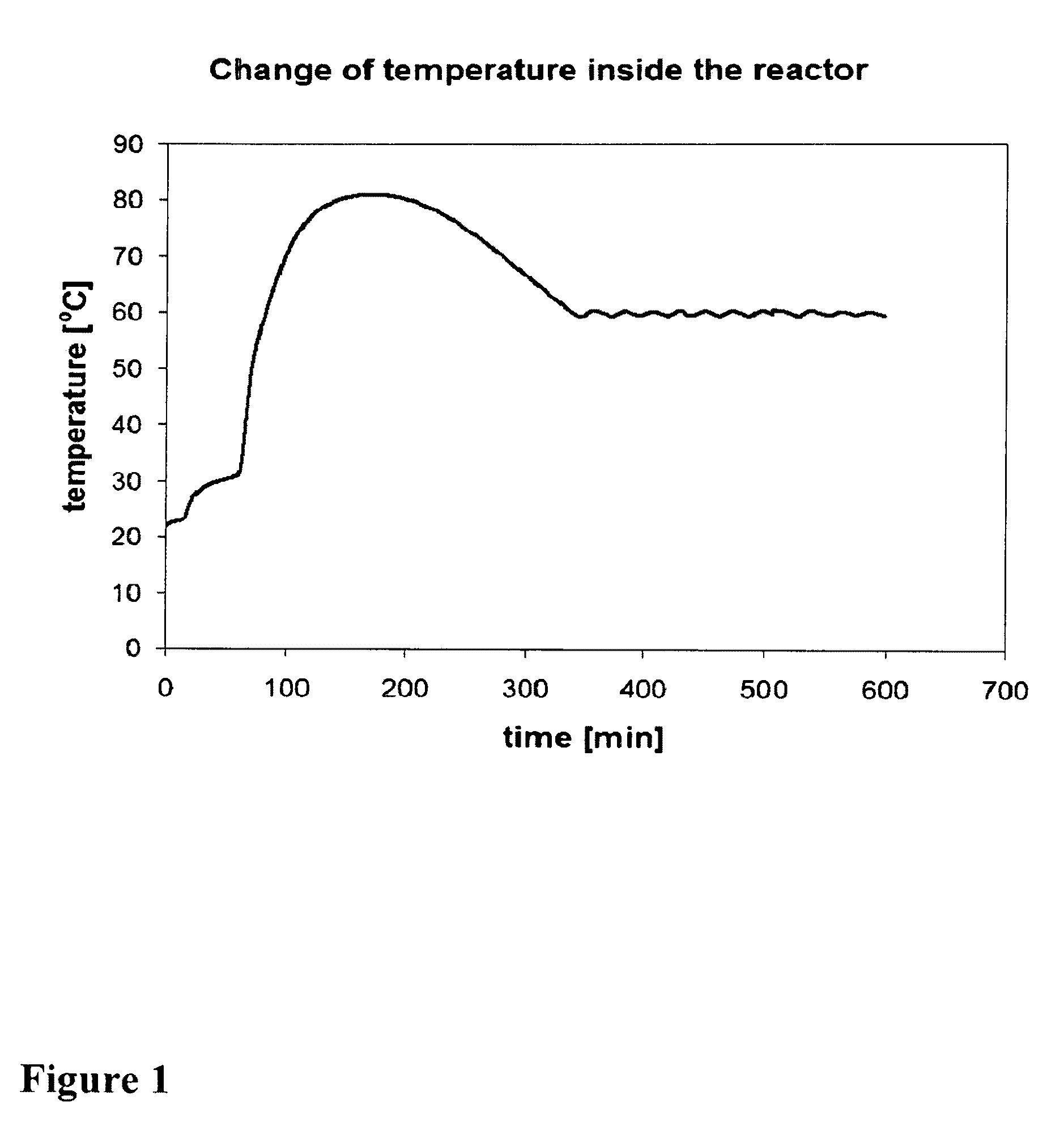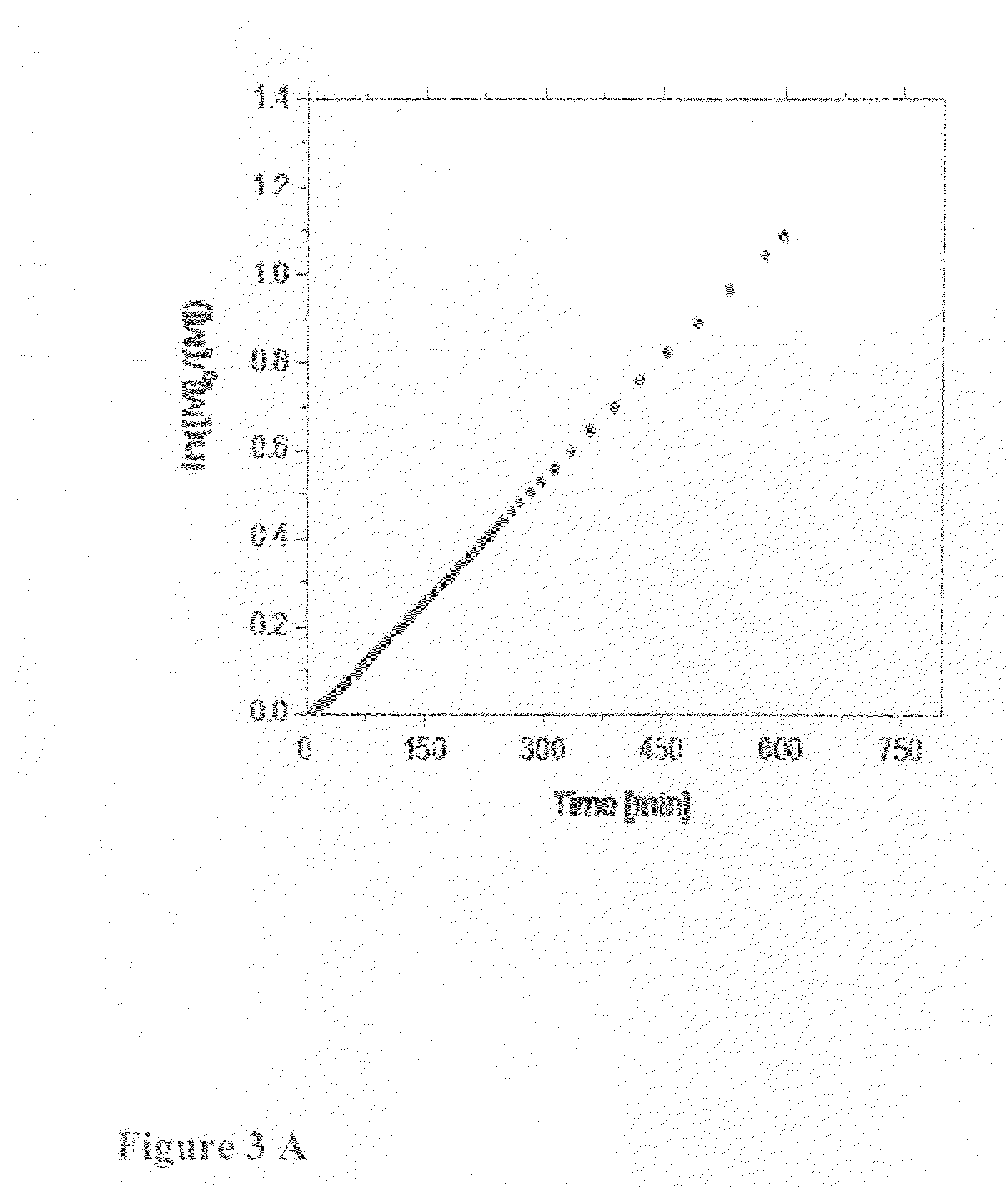Control over controlled radical polymerization processes
a polymerization process and control technology, applied in the field of control over controlled radical polymerization processes, can solve the problems of increasing the decomposition rate of initiators, and achieve the effects of reducing waste, reducing purification cost, and improving safety
- Summary
- Abstract
- Description
- Claims
- Application Information
AI Technical Summary
Benefits of technology
Problems solved by technology
Method used
Image
Examples
example 1
Polymerization of Methyl Methacrylate (MMA)
[0124]Polymerization of MMA was carried out first using the new ‘feeding’ method for ICAR ATRP. The best polymerization conditions were chosen from the computer modeling and tested in a 1 liter scale reactor. The temperature inside the reactor was followed using a thermocouple with a second thermocouple located outside the reactor, between the wall of the reactor and the heating mantle to provide additional information of the level of temperature control attained in the reaction. The difference in temperature between the two thermocouples can be related to the efficiency of heat transfer in this system. The efficiency of heat transfer may change significantly with viscosity and will affect the control of polymerization.
[0125]Another factor which computer modeling does not take into account is the rate of diffusion of the radical initiator after feeding into a viscous solution. The radical initiator should be evenly distributed before signif...
example 2
Polymerization of n-Butyl Acrylate
Computer Simulations for Polymerization of N-Butyl Acrylate:
[0129]A computer model similar to that shown in FIG. 2 was built and then polymerization simulations were performed for n-butyl acrylate (nBA). The main goal of the simulations was to find starting conditions for real polymerization experiments by varying several different parameters in the software; type of radical initiator, degree of polymerization DP, feeding rate of radical initiator.
[0130]One of the goals for new polymerization method with controlled feeding of the initiator / activator was to make polymerization reactions as fast as possible and at the same time still have a controlled process. As in the case of PMMA, evaluation of simulated results for PnBA was based on these factors and new evaluation scale was introduced. The scale was slightly different than that for MMA due to relatively faster reactions for nBA type monomer.
Relative Control Scale Description:
[0131]Very good: conv...
example 2a
Preparation of PnBA Via Starved Feeding ICAR ATRP
[0135]Four of the best polymerization conditions were chosen from the modeling stage and first tested in a 1 liter scale reactor. The experimental set up had one difference in comparison with MMA system; the reactor was equipped with a cooling coil, needed for safety reasons—as reactions with acrylates are more exothermic. As discussed in the background, we anticipate much less exothermic effects for the “starved” feeding method. The parameters that were adjusted are: temperature, targeted DP, feed rate of radical initiator, concentration of reagents, and amount of Cu catalyst.
Run: 08-006-57
[0136]Scale: 1 L reactor
Conditions: nBA / DEBMM / CuBr2 / TPMA / AIBN=2000 / 1 / 0.02 / 0.04 / 0.04 in bulk (anisole as internal standard), (10 ppm of Cu), T=90° C., time=7.5 hours.
[0137]The rate of addition of the AIBN solution of 34.5 mg AIBN in 15 ml of toluene was 2 ml / h, which is equivalent to adding 0.01 eq. AIBN / h compared to the amount of ATRP initiator ad...
PUM
| Property | Measurement | Unit |
|---|---|---|
| Fraction | aaaaa | aaaaa |
| Fraction | aaaaa | aaaaa |
| Fraction | aaaaa | aaaaa |
Abstract
Description
Claims
Application Information
 Login to View More
Login to View More - R&D
- Intellectual Property
- Life Sciences
- Materials
- Tech Scout
- Unparalleled Data Quality
- Higher Quality Content
- 60% Fewer Hallucinations
Browse by: Latest US Patents, China's latest patents, Technical Efficacy Thesaurus, Application Domain, Technology Topic, Popular Technical Reports.
© 2025 PatSnap. All rights reserved.Legal|Privacy policy|Modern Slavery Act Transparency Statement|Sitemap|About US| Contact US: help@patsnap.com



